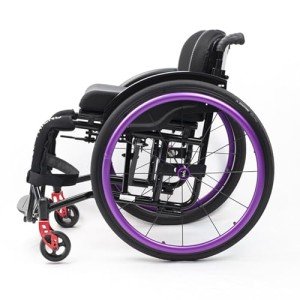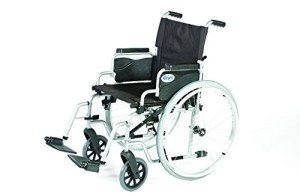5 Killer Quora Answers On How To Self Propel A Wheelchair
페이지 정보
작성자 Avery 댓글 0건 조회 22회 작성일 25-02-06 10:04본문
 How to Self Propeller a Wheelchair
How to Self Propeller a WheelchairLearning to self propelled wheelchair with suspension-propel in a wheelchair can open an entire new world of independence. It requires practice and the correct body position to achieve this.
A proper body position requires an exact grip and pushing technique. This article will concentrate on these skills, as well as other important aspects of wheelchair propelling.
Hand Positioning
self propelled wheelchair uk-propulsion is an essential component of self-propulsion. It's best to start with precision and then move to speed. It's also an excellent idea to sit down while pushing to improve the stability and comfort, particularly for those who have upper body restrictions. Hands should be placed in a way that they are aligned with the speed of the wheel. Push with both hands, without wrapping thumbs around hand-rims. This is a common error which decreases efficiency and can increase the force required per stroke.
The recovery path of the hands should be performed in an open pendular manner beneath the hand-rims following each propelling cycle to avoid contact with the rear wheels (a "semi-circular" recovery pattern). This reduces the strain on the shoulders, while keeping the duration of each stroke and the number of cycles to the minimum.
For more challenging surfaces, it is sometimes recommended that the wheelchair user make long strokes and a full recovery (like the hand position on the clock). This can reduce shoulder injuries due to repetitive motion, but it can also increase the load at the shoulders.
It is also possible to reduce shoulder injuries by utilizing the same position while stopping and propelling. If the wheelchair user can keep a steady rhythm during both movements it will be simpler to manage the forces that are applied and adjust for variations in the terrain.
On muddy or soft surfaces it is common to lean forward slightly when driving, to prevent the front wheels from sinking into ground and then tipping backwards. You should experiment with different trunk leans to find the ideal balance between too much and How To Self Propel A Wheelchair too little lean. Regular practice will improve your confidence and proficiency. Wheelchair propulsion is a transformative skill for people with mobility issues. Anyone can learn how to self propel A wheelchair to drive a manual wheelchair with ease if they have the right equipment, technique and knowledge. This entry was posted under News and was tagged with wheelchair.
Foot Positioning
It is crucial to ensure that the patient's feet are properly positioned for stability. It is not advisable to set the wheelchair's feet too far apart since it makes it difficult for the wheelchair to self-propel. Sometimes it what is the lightest self propelled wheelchair necessary for the wheelchair to have this type of configuration to be able to navigate through difficult terrain. If the client is attempting to climb an incline, or even over the stunning National Parks and beaches in the United States, the wheelchair needs wheels that can slide over them so that the person can move forward. This is done by having the front wheels positioned in the manner shown in the photo below.
When the person is equipped with this system, they can grab the rims of the wheels and push them together to advance. This requires an enormous amount of upper strength and is extremely slow however it is possible and it can allow clients who would otherwise not be able to get down or up hills to achieve this.
Wheelies are also essential to help the user get over obstacles like curbs or people. In this situation, the client will place their left foot on top of their right, so that they can lift themselves up and over the obstacle. The client will then move their right leg upwards and over the obstacle, while pushing with their left hand. This is referred to as a crab walk, and it can be an effective way of moving a wheelchair over some of our most challenging terrain.
They're a great choice for disabled or injured people who wish to move about without assistance. They are lightweight, versatile and can be folded away to not take up as much space as other mobility aids do. With the help of accessories such as the E-Motion they can be converted into powerchairs, giving the user freedom to use their chair, and the benefit of electrical assistance when required.
Braking
The ability to self propel in a wheelchair is an essential skill for people who have mobility issues. They can maneuver through a variety of environments and terrains on their own. It also helps build strength in the upper arms and shoulders.
The user should push down on one side of the hand rim, then pull up the opposite side to propel the wheelchair forward. This push-pull action creates momentum, which propels the wheelchair in the direction desired by the user. You can alter the speed of the wheelchair by applying more or lesser pressure to the wheels, or by using the hand brakes when they're equipped.
Ideally, the push cycle should last three hours or more. This will reduce the time that the shoulder is strained, minimizing the likelihood of injury from repetitive strain. The speed that the wheelchair is pushed will be influenced by the size and width of the rear wheels. Smaller wheels are more comfortable to maneuver, while larger wheels require more effort. Wheelchairs can also be designed with camber, which increases the ease of pushing by aligning the rear wheels with the biomechanics of the shoulders and maximizing the lateral stability.
Wheelchair users looking to improve their propulsion skills should practice in a safe space, like a parking lot or how to Self propel a wheelchair a hall that is empty. The goal is to create long smooth strokes that permit the wheelchair to coast in between strokes.
It is also crucial that the user practice maneuvering when moving, such as turning or weaving around objects. This can be achieved by weaving through cones and then moving to straight lines. The more you practice, the easier this will be.
self propelled wheelchair with removable arms-propelled wheelchairs can be a great device to allow people to stay active and do the things they love. They can provide independence and be a great option to meet with friends or go to the movies, or even travel. If you can learn to use a wheelchair properly you can restore your independence and get where you want to be.
Stability
A person who is a wheelchair user who self-props the chair can be able to independently go where they want to go without relying on others. It requires an enormous amount of strength in the upper part of the body, however it is necessary to push the wheels on flat surfaces or up small hills. This is why many wheelchair users choose to use an attendant controlled (also called an attendant propelled) chair like the Action3 NG or ErgoLite 2 and are pushed by an attendant.
Hand rims are grasped to move in a manual wheelchair is among the most important aspects to master for optimum efficiency and comfort. We frequently find that people who are using this type of chair tend to have their hand rims too far forward, which means they are forced to reach further backward with their arms. This is not efficient biomechanically and could cause shoulder strain over time.
The optimal hand-propulsion motion is a semi-circular pattern where the client is alternating between the push phase and the recovery phase. The push phase involves the person pushing downwards on the wheels of the wheelchair, which requires the use of a large number of small strokes. This push pattern helps to maintain a healthy range and exercise the shoulder retractor muscle.
The client should move their hands along the rims until their hands make contact with the casters. This allows for longer strokes, and reduces friction during the recovery phase. Some wheelchair users slide their hands along the rims of the wheels in a smooth circular motion, but this method isn't as effective. It also causes additional wear on the wheels.
The location of the rear wheels for self-propulsion is an additional aspect of stability. If the wheel is placed too far to the left the wheelchair could easily tip. This could make it difficult for them to maneuver around obstacles, and it's not a good idea for shoulder injuries. In order to determine which wheel is best for a client it is necessary to evaluate their strength, range-of-motion as well as muscle tone, orthopedic status, and other factors during the seat assessment.

댓글목록
등록된 댓글이 없습니다.